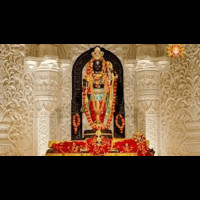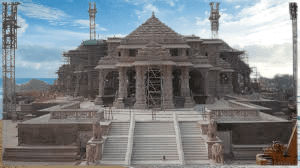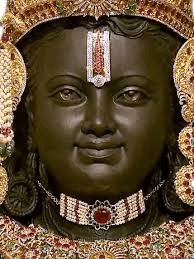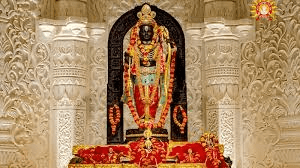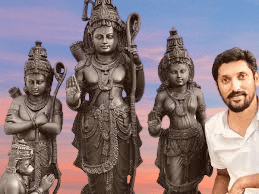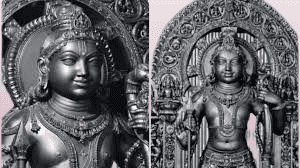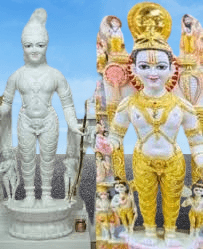Ayodhya in the state of Uttar Pradesh in India was in grip of religious fervour as long-awaited Pran Pratishtha ceremony of Ram Lalla took place on Monday, 22nd Jan’2024 in the presence of Prime Minister Narendra Modi, RSS Chief Mohan Bhagwat and other dignitaries.
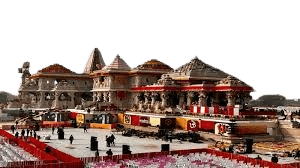
The Ram Mandir is a Hindu temple complex in Ayodhya, Uttar Pradesh, India. Many Hindus believe that Ayodhya Ram Temple located at the site of Ram Janmabhoomi, the mythical birthplace of Rama, a principal deity of Hinduism. The Ram temple was inaugurated on 22 January 2024 after a prana pratishtha (consecration) ceremony. On the first day of its opening, following the consecration, the Ram temple received a rush of over half a million visitors, and after a month, the average number of visitors was reported to be “1 to 1.5 lakh (100,000 to 150,000) on a daily basis”
Ayodhya Ram Temple
Shri Ram Mandir or Ayodhya Ram Mandir, Birth Place of Lord Ram
A Hindu temple that is being built in Ayodhya, Uttar Pradesh, India, at the site of Ram Janmabhoomi, the birthplace of Lord Ram, a principal deity of Hinduism.
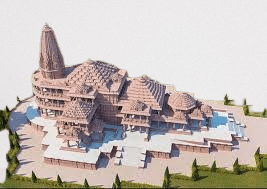
The Ayodhya Ram temple construction is being supervised by the Shri Ram Janmabhoomi Teerth Kshetra. The ground-breaking ceremony was performed on 5 August 2020 by India’s prime minister Narendra Modi.
Ayodhya Ram Temple Construction Fact
Facts about new Shri Ram Janbhoomi temple under construction
Pran Pratishtha ceremony of Ayodhya Ram Temple
Army helicopters showered flower petals on the temple premises when the consecration took place. Crafted by the skilled hands of sculptor Arun Yogiraj from Mysuru, the 51-inch-tall idol, captures the image of a five-year-old Lord Ram standing gracefully on a lotus, all meticulously carved from a single block of stone. The grand event saw the presence of around 7,000 VVIPs from across the nation which includes actors, sportspersons, industrialists, politicians, etc.
Constructed in the conventional Nagara architectural style, the Ram Mandir compound is designed to span 380 feet in the east-west direction, with a width of 250 feet and an impressive height of 161 feet. The temple’s vertical structure consists of floors, each measuring 20 feet in height, supported by a remarkable ensemble of 392 pillars and adorned with 44 gates.
PM Modi followed a strict 11-day ‘anushthan’ and slept on the floor and had coconut water before the ceremony in Ayodhya on January 22. He also visited several temples across India ahead of the ‘pran-pratishtha’ ceremony of the Ram Mandir and took a holy dip at the Rameswaram ‘Angi theerth’ beach.
While addressing the gathering in Ayodhya after performing rituals in the Ram Temple consecration ceremony, PM Modi congratulated the people as the hundred years long wait ended on Monday. After the consecration of Ram Temple in Ayodhya, PM Modi encouraged people to “lay foundation of India of next 1,000 years; We take pledge to build a capable, grand, divine India from this moment.” “Ram temple’s construction will set off a firestorm. They should reconsider as Ram is energy, not fire, a solution not dispute,” said PM Modi in Ayodhya on Monday.
Around 20,000 packets of ‘mahaprasad’ were prepared to distribute among the invitees and devotees.
Prana Pratishtha
Prana Pratishtha is the rite or ceremony by which a murti (devotional image of a deity) is consecrated in a Hindu temple, wherein hymns and mantra are recited to invite the deity to be resident guest, and the murti‘s eye is opened for the first time. Practised in the temples of Hinduism and Jainism, the ritual is considered to infuse life into the Hindu temple, and bring to it the numinous presence of divinity and spirituality.
The ceremony marks the recognition of the image of god to represent “a particle of the divine whole, the divine perceived not in man’s image as a separate entity but as a formless, indescribable omnipresent whole”, with the divine presence a reminder of its transcendence and to be beheld in one’s inner thoughts during darsana in the temple.
Ayodhya Ram Mandir Prana Pratishtha
Ayodhya Ram Mandir Prana Pratishtha refers to the consecration ceremony of the Ram Mandir which was held on 22 January 2024. The event was organized by Shri Ram Janmabhoomi Teerth Kshetra.
On 22 June 2023, Ram Mandir Temple Construction Committee chairman Nripendra Misra announced that the ground floor of the three-story temple was complete and was expected to open for the devotees in January 2024. The Ram Mandir Teerth Kshetra Trust announced that Hindu astrologers, according to Hindu Panchang, have selected 22 January 2024 as the auspicious date for the consecration ceremony. In October 2023, the committee members formally invited Prime Minister Narendra Modi to do the Prana Pratishtha of the newly made idol in the sanctum sanctorum.
The trust along with the Government of Uttar Pradesh and city administration carried out extensive preparations to accommodate the large crowds of devotees and the influx of invited guests from all over the world. The Government of Uttar Pradesh announced public holiday in the state and applied strict security measures in and around the temple premises. The security of complete city of Ayodhya was beefed up in view of VIP movements. The Government of India along with some state governments declared a half day holiday marking the event for its employees.
In preparation for the Pran Pratishtha ceremony, the Government of Uttar Pradesh has earmarked ₹100 crore (US$13 million) for ‘Ramotsav’, a series of religious events spanning 826 local bodies across Uttar Pradesh and the Ram Paduka Yatra. Commencing in December 2023, the events were culminated in grand celebrations from Makar Sankranti on 16 January 2024, until the inauguration of the Ram temple on 22 January. The yatras were followed the Ram Van Gaman Path, retracing Rama’s 14-year exile from Ayodhya.
Out of the three idols prepared, the one prepared by famous sculptor from Karnataka Arun Yogiraj was selected to placed in the sacred sanctum sanctorum.
The consecration ceremony of Ram Mandir was complete by the Prime Minister of India, Narendra Modi on 22 January 2024 from 12:15 PM to 12:45 PM IST.
The trust invited Indian Prime Minister Narendra Modi to perform the rituals. Modi was on a special 11-day fast ritual for the consecration at the Ram Janmabhoomi Temple. In this ritual, he consumed coconut water and fruits and slept on the ground at night.
Prime Minister Modi urged every Indian to light up diyas to mark the occasion and celebrate it like Diwali.
Key Highlights of the Pran Pratishtha ceremony of Ayodhya Ram Mandir
1 – PM Modi performed the Pran Pratishtha ceremony of the Ram Lalla idol at the Shri Ram Janmabhoomi Temple in Ayodhya. Later he performed the ‘aarti’ of the Ram Lalla idol inside the sanctum sanctorum affter the idol was unveiled at the temple in the presence of the prime minister.
2 – After performing the whole ritual, PM Modi addressed the gathering at the temple and congratulated people. “Lord Ram has finally arrived (in his abode) following the wait of centuries. After the patience that we showed for centuries and the sacrifices we made, our Lord Ram has finally arrived,” PM Modi said during his address.
3 – After addressing the gathering, PM Modi offered prayers at Kuber Tila Shiva temple and unveiled Jatayu statue. The ancient Shiv temple located on the Kuber Tila in the Ram Janmabhoomi complex is also being renovated by the Shri Ram Janmabhoomi Teerth Kshetra Trust, which is constructing the Ram temple. Later, he showered flower petals upon the workers who were the part of the construction crew of the Ram Mandir.
4 – The stone used to create the 51-inch Ram Lalla idol is special black granite sourced from Karnataka. “The stone is 2.5 billion years old,” confirmed HS Venkatesh, Director of the National Institute of Rock Mechanics (NIRM) in Bengaluru.
5 – The temple, built in Nagara style, is supported by a total of 392 pillars and 44 doors. The pillars and walls of the temple showcase intricately sculpted depictions of Hindu deities, Gods, and Goddesses.
6 – About 2,500 musicians performed on over 100 stages for the crowds of pilgrims around the elaborate temple, built at an estimated cost of ₹ 1,800 crore that the project’s backers say was sourced from public donations.
7 – More than 100 charter planes landed at the Ayodhya airport, which was built in a record time of 20 months ahead of the big temple ceremony. They were parked at airports like Lucknow, Prayagraj and Gorakhpur.
8 – Special immigration arrangements were made for UK billionaire Lakshmi Mittal, who reached Ayodhya directly from London. Mukesh Ambani, along with his family, was also present at the occasion. His family pledged ₹ 2.51 crore to the temple.
9 – The invitation cards carried a barcode known as QR or quick response, which helped a great deal in security arrangements.
10 – Around 20,000 packets of ‘mahaprasad’ were prepared to distribute among the invitees and devotees. The packets, say reports, contained gur ki revdi, ghee mawa ladoo, ramdana chikki, Tulsi daal, akshat and roli, Ram diya and cardamom seeds.
11 – Twenty-two movable barriers with barbed wires attached to them were placed on crossroads and security personnel put in place 10,000 CCTV cameras and deployed Artificial Intelligence-powered drones to keep an eye on the movement of people. Private security also had to be deployed.
12 – Hoping for an “auspicious” start for their newborns, many couples had ‘muhurat deliveries’, planned in consultation with doctors, in hospitals on Monday coinciding with the Ram Lalla idol consecration in Ayodhya.
India’s Prime Minister Narendra Modi has hailed Monday’s consecration ceremony as “the beginning of a new time cycle” in a speech to thousands of guests outside temple’s complex.
“Today our Lord Ram has come. After centuries of waiting, our Ram has arrived,” Modi said. “Our Ram idol will not stay in a tent anymore. Our Ram idol will stay in a divine temple now.”
He added: “The sun of 22 January, has brought with it a wonderful aura. 22 January 2024 is not just a date on a calendar but a beginning of a new time cycle.”
“Even a thousand years later, people will be discussing this date and time,” Modi said in his speech.
Tourism
Ayodhya is well-connected by air, rail and road to major cities of India. Anyone can reach directly by any of these mode of transport.
Very soon city will be reachable by Waterways as well.
How To Reach Ayodhya Ram Mandir?
By Air
The Maharishi Valmiki International Airport (IATA: AYJ, ICAO: VEAY), is in Ayodhya Dham. Lucknow airport is also only 150 km west of the city. There are taxis and jeeps available from the airport to reach Ayodhya.
Airlines serving flight to Ayodhya:
SpiceJet, IndiGo, Air India Express, Akasa Air, Alliance Air, Zooom Air
Connected cities:
Bangalore, Delhi, Gwalior, Kolkata, Pune, Dehradun, Ahmedabad, Chennai, Darbhanga, Hyderabad, Jaipur, Mumbai, Patna
By Train
Ayodhya railway station is an important junction in North India. It is well connected to Delhi, Lucknow, Kanpur, Varanasi, Gorakhpur and Gonda. The railway station is less than two km away from the Ram Janmbhoomi Temple.
By Road
For the great welcome of devotees, a newly constructed bus station “Ayodhya Dham” has been opened.
Important contact numbers:
- Ayodhya Bus Stand: 7752951415 / 6306757599, 05278222964
- Official Site:- https://upsrtc.up.gov.in/en/article/enquiry-number
- Helpline Number:- 1800-180-2877 (24×7)
Intercity AC e-bus services are all time available from bus stand to whole city, including Ayodhya Ram Mandir.
Given its religious significance among Hindus, it is estimated that with 50 million annual visitors, Ayodhya Ram temple is likely to become the most visited Hindu pilgrimage site in India. After the opening of the Ram Temple to public on 23 January 2024, Ayodhya welcomed 2.4 million visitors in the12 days.
Based on the current visitor numbers, the Ayodhya’s Ram temple is projected to become one of the most visited pilgrimage sites in the world, surpassing Mecca and the Vatican. Given the temple rush by devotees from all parts of India, it was estimated that spiritual tourism at Ayodhya has potential to create thousands of jobs as more manpower is required to cater the needs of the Ram mandir visitors and also attract huge investments.
On April 17, 2024, the first Ram Navami (Ram’s birth) festival after the consecration of the Ram Temple was celebrated by thousands of devotees. On this occasion, the Ram Temple witnessed a unique event at noon as the forehead of the Ram Lalla idol was anointed with a ray of sunlight, known as Surya Tilak. As the sun rays illuminated the forehead of the Lord Ram Lalla idol, scores of devotees celebrated the event.
The development of the ‘Surya Tilak’ mechanism involved collaboration between scientists from Central Building Research Institute (CBRI), Roorkee, and the Indian Institute of Astrophysics (IIAP), Bengaluru, who devised a sophisticated apparatus consisting of mirrors and lenses to direct a beam of light to the deity’s forehead, marking a significant scientific feat.
The Ram Temple in Ayodhya attracts a daily crowd of 1 to 1.5 lakh pilgrims. Specific rules, including leaving belongings outside and obtaining entry passes for certain Aartis, are in place. Wheelchairs are available for the elderly and differently-abled.
For more interesting articles, please visit read4knowledge.com
